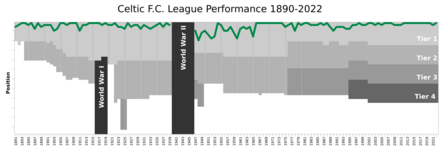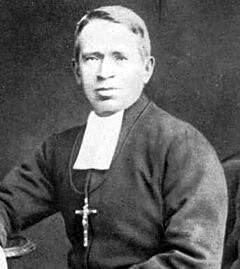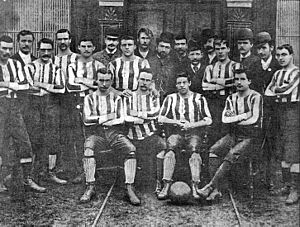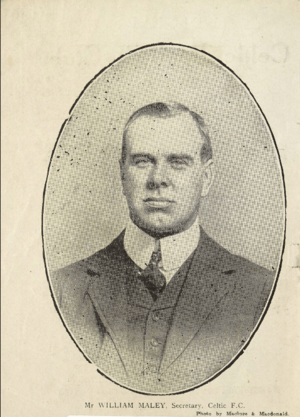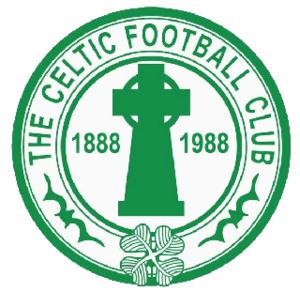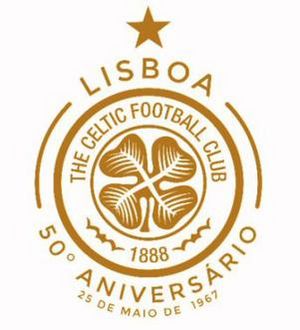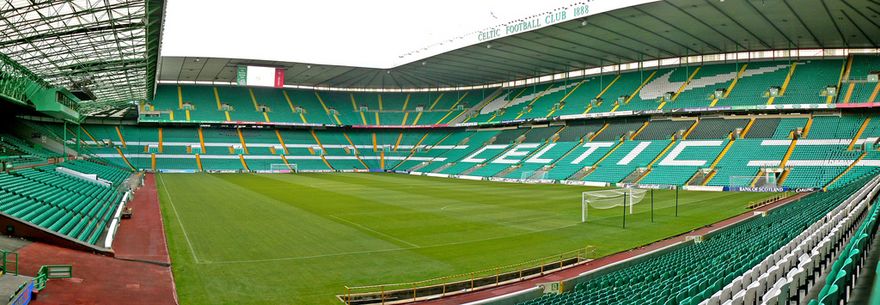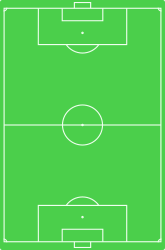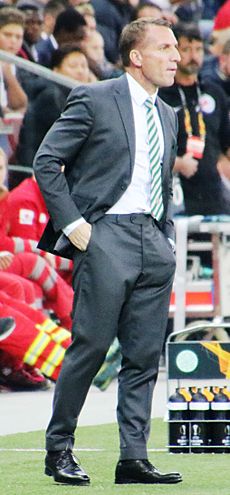Celtic F.C. facts for kids
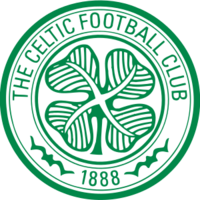 |
||||
| Full name | The Celtic Football Club | |||
|---|---|---|---|---|
| Nickname(s) | The Bhoys The Celts The Hoops |
|||
| Founded | 6 November 1887 | |||
| Ground | Celtic Park | |||
| Capacity | 60,411 | |||
| Owner | Celtic PLC (LSE: CCP) | |||
| Chairman | Peter Lawwell | |||
| Manager | Brendan Rodgers | |||
| League | Scottish Premiership | |||
| 2015–16 | Scottish Premiership, 1st (champions) | |||
|
||||
The Celtic Football Club, often called Celtic, is a professional football team from Glasgow, Scotland. They play in the Scottish Premiership, which is the top football league in Scotland. The club started in 1887 to help people in need in the East End of Glasgow. Their first game was in May 1888 against Rangers, which Celtic won 5–2.
Celtic quickly became a strong team in Scottish football. They won six league titles in a row in the early 1900s. Their most successful time was in the 1960s and 70s under manager Jock Stein. During this period, they won nine league titles in a row and the European Cup in 1967. Celtic has always worn green and white, adopting their famous hoops design in 1903.
Celtic is one of only seven clubs in the world to have won over 100 trophies. As of 2025, they have 120 major honours, more than any other European club. They have won the Scottish league championship a record 55 times, most recently in 2024–25. They also hold the record for the most Scottish Cup wins (42 times) and have won the Scottish League Cup 22 times. Their best season was 1966–67, when they became the first British team to win the European Cup. They also won the Scottish league, Scottish Cup, League Cup, and Glasgow Cup that season. Celtic also reached the finals of the 1970 European Cup Final and the 2003 UEFA Cup Final, but lost both.
Celtic has a big rivalry with Rangers, and their games are known as "The Old Firm". These matches are considered some of the biggest football derbies in the world. In 2003, it was estimated that Celtic had about 9 million fans worldwide. There are over 160 Celtic fan clubs in more than 20 countries. About 80,000 fans traveled to Seville for the 2003 UEFA Cup Final. Even though Celtic lost, their "extraordinarily loyal and sporting behavior" earned them Fair Play awards from both FIFA and UEFA.
Contents
Club History
Celtic Football Club was officially started by Brother Walfrid on November 6, 1887. This happened at a meeting in St. Mary's church hall in Glasgow. Brother Walfrid was an Irish Marist brother. He wanted to help poor children in Glasgow by raising money for his charity, the Poor Children's Dinner Table. He was inspired by another club, Hibernian, which also helped the Irish community in Edinburgh. Walfrid suggested the name Celtic to show the club's Irish and Scottish roots. The club's official nickname is The Bhoys. This unique spelling with an extra 'h' is like how some words are spelled in Scottish Gaelic.
On May 28, 1888, Celtic played their first official game against Rangers and won 5–2. Neil McCallum scored Celtic's first goal. Celtic's first uniform was a white shirt with a green collar, black shorts, and green socks. The first club badge was a green cross on a red oval. In 1889, Celtic reached the Scottish Cup final in their first season but lost. They reached the final again in 1892 and won their first major trophy by beating Queen's Park 5–1. A few months later, the club moved to its new home, Celtic Park. The next season, they won the Scottish League Championship for the first time. In 1895, Celtic set a league record by winning a home game 11–0 against Dundee.
In 1897, Celtic became a private company, and Willie Maley became the first "secretary-manager". Between 1905 and 1910, Celtic won the Scottish League Championship six times in a row. They also won the Scottish Cup in 1907 and 1908, becoming the first Scottish club to win the double (both the league and cup). During World War I, Celtic won the league four times in a row. They had an amazing 62-match unbeaten run between November 1915 and April 1917. In the mid-1920s, Jimmy McGrory became one of the best goal scorers in British football history. He scored 550 goals in 547 games over 16 years. This is still a British goal-scoring record today. Willie Maley retired in January 1940 after serving the club for almost 52 years. Jimmy McStay became manager in February 1940. Due to World War II, there was no official league football during his time. Celtic won the Victory in Europe Cup in May 1945, a special match to celebrate the end of the war.
Former player and captain Jimmy McGrory became manager in 1945. Under him, Celtic won the Coronation Cup in 1953, a special tournament for Queen Elizabeth II's coronation. He also led them to win both the League and Cup in 1954. On October 19, 1957, Celtic beat Rangers 7–1 in the Scottish League Cup final. This is still a record win in a British domestic cup final. However, after this, Celtic struggled and didn't win more trophies under McGrory.
Jock Stein, a former Celtic captain, became manager in 1965. He won the Scottish Cup in his first few months. The next season, he led them to win the League title.
The year 1967 was amazing for Celtic. The club won every competition they entered: the Scottish League, Scottish Cup, Scottish League Cup, Glasgow Cup, and the European Cup. This made Celtic the first club to win the European Treble (three major trophies). They are still the only club to win the "Quadruple" (four major trophies). Under Stein, the team beat Inter Milan 2–1 in Lisbon on May 25, 1967. This made them the first British team to win the European Cup. They are still the only Scottish team to have reached this final. The players from that day, all born near Glasgow, are known as the "Lisbon Lions". The next season, Celtic lost to Racing Club of Argentina in the Intercontinental Cup.
Celtic reached the European Cup Final again in 1970, but lost 2–1 to Feyenoord. The club continued to be very strong in Scottish football in the early 1970s. Their Scottish Championship win in 1974 was their ninth league title in a row. This equaled a world record at the time.
Celtic had more success in the 1980s. In their Centenary season of 1987–88, they won both the Scottish Premier Division and the Scottish Cup.
The club faced difficulties in the early 1990s. In March 1994, the club was close to going bankrupt. However, businessman Fergus McCann took control of the club. He changed Celtic into a public limited company (Celtic PLC). He also oversaw the rebuilding of Celtic Park into a large, modern stadium with 60,832 seats. In 1998, Celtic won the league title again under manager Wim Jansen. This stopped Rangers from beating Celtic's nine-in-a-row record.
Martin O'Neill became manager in June 2000. Under him, Celtic won three SPL championships in five years. In his first season, the club won the domestic treble, making O'Neill only the second Celtic manager to do so after Jock Stein. In 2003, about 80,000 Celtic fans traveled to Seville for the UEFA Cup Final. Celtic lost 3–2 to Porto after extra time, even with two goals from Henrik Larsson. The behavior of the Celtic fans was highly praised, and they received Fair Play Awards from both FIFA and UEFA.
Gordon Strachan took over in June 2005. He won the SPL title in his first year and became the third Celtic manager to win three titles in a row. He also led Celtic to the UEFA Champions League knockout stage in 2006–07 and 2007–08. He left in May 2009. Tony Mowbray became manager in June 2009, followed by Neil Lennon a year later. In November 2010, Celtic set an SPL record for their biggest win, beating Aberdeen 9–0.
Celtic celebrated their 125th anniversary in November 2012. That same week, they won a Champions League match against Barcelona 2–1. They reached the knockout stages of the competition. Celtic ended that season by winning both the SPL and Scottish Cup. The club won their third league title in a row in March 2014. Goalkeeper Fraser Forster set a new record of 1,256 minutes without letting in a goal in a league match. Neil Lennon left the club after four years as manager.
Norwegian Ronny Deila became manager on June 6, 2014. He led the team to two league titles and a League Cup. However, their performance in European competitions was not as good. After losing to Rangers in the Scottish Cup in April 2016, Deila announced he would leave.
On May 20, 2016, Brendan Rodgers became the new manager. In his first season, the team had a long unbeaten run in domestic games. During this time, they won their 100th major trophy, beating Aberdeen 3–0 in the League Cup Final in November 2016. Celtic also won their sixth league title in a row in April 2017, with eight games left to play. They finished with a record 106 points, becoming the first Scottish team to complete a top-flight league season without losing since Rangers in 1899. Celtic won their fourth treble by beating Aberdeen 2–1 in the 2017 Scottish Cup Final. This meant they went through the entire domestic season without a single defeat.
Celtic continued their unbeaten domestic run into the next season, reaching 69 games. This broke their own 100-year-old British record of 62 games. They finally lost to Hearts in November 2017. Celtic won the League Cup again that same month and secured their seventh league title in a row in April 2018. They then beat Motherwell again in the 2018 Scottish Cup Final to win a second consecutive domestic treble. This was the first time a club in Scotland had done this. Rodgers left the club during the next season to join Leicester City. Neil Lennon returned as caretaker manager and helped Celtic win an amazing third consecutive domestic treble, beating Hearts 2–1 in the 2019 Scottish Cup Final. He was then confirmed as the new manager.
In December 2019, Lennon led Celtic to a 1–0 win over Rangers in the 2019 Scottish League Cup Final. This was the club's tenth domestic trophy in a row. By March 2020, Celtic was 13 points ahead in the league when football in Scotland was stopped due to the COVID-19 pandemic in the United Kingdom. They were confirmed as champions in May 2020. The 2019–20 Scottish Cup final was delayed until late 2020. Celtic won on penalty-kicks after a 3–3 draw, securing a fourth straight treble. However, Celtic struggled in the 2020–21 season. They were knocked out of the League Cup and by February 2021, they were far behind Rangers in the league. Lennon resigned on February 24, 2021. Celtic finished the season without a trophy for the first time since 2010.
On April 26, 2025, Celtic won 5–0 against Dundee United. This secured their fourth consecutive league title. It was their 13th title win in the last 14 league seasons.
Team Colours and Crest
For most of Celtic's history, their home uniform has been green and white horizontal hoops. But their first uniform was a white top with black shorts and black and green hooped socks. The top also had the Marist Brothers' badge, a green Celtic cross in a red circle. In 1889, the club changed to green and white vertical stripes. This design stayed for 14 years, though the shorts changed between white and black. The top did not have a crest.
In 1903, Celtic adopted their famous green and white hooped tops. They wore this new design for the first time on August 15, 1903. Black socks were worn until the early 1930s, when the team switched to green socks. Plain white socks became common in the mid-1960s and have been the main color since then.
|
1888
|
1889–1903
|
1903–1932
|
1932–1965
|
1965 onwards
|
The club started using a badge in the 1930s. It had a four-leaf clover with the club's full name around it. However, it wasn't until 1977 that Celtic put the club crest on their shirts. For their 100th anniversary in 1988, a special crest with the Celtic cross was used. The 1977 version returned for the 1989–90 season.
From 1945, numbered shirts slowly became common in Scotland, becoming required in 1960. Celtic was the last British club to use numbers on their uniforms. The club chairman, Robert Kelly, didn't want to "disfigure" the famous hoops. So, Celtic wore numbers on their shorts instead. This unusual tradition lasted until 1994. However, they did wear numbered shirts in European games from 1975. The Scottish Football League eventually told Celtic to put numbers on their shirts from the 1994–95 season. Celtic first put them on their sleeves, but then had to move them to the back of the shirts on a large white patch.
In 1984, Celtic got their first shirt sponsor, CR Smith. In 1991–92, they switched to Peoples. For the 1992–93 season, Celtic didn't have a shirt sponsor. Sales of the plain hooped shirts went up a lot. CR Smith returned as sponsor for the 1993–94 season.
In 2005, the club stopped working with Umbro, who had supplied their kits since the 1930s. They signed a deal with Nike. To celebrate the 40th anniversary of their European Cup win, a special crest was used for the 2007–08 season. The star representing this win stayed on the regular crest after that. In 2012, Nike designed a retro-style kit with narrower hoops for the club's 125th anniversary. A special crest with a Celtic knot design was also used. A third uniform, like the first one from 1888, was also worn that season.
In March 2015, Celtic signed a new kit deal worth £30 million with New Balance. This replaced Nike starting from the 2015–16 season.
All the kits for the 2017–18 season honored the Lisbon Lions. The kits had a line on each side to look like the handles of the European Cup. They also had a special commemorative crest. The regular crest returned the next season.
In March 2020, Celtic announced a new five-year partnership with Adidas. This deal started on July 1, 2020, and is believed to be the biggest kit sponsorship in Scottish sports history.
| Period | Kit manufacturer | Shirt sponsor (front) | Shirt sponsor (back) |
|---|---|---|---|
| 1936–1984 | Umbro | none | none |
| 1984–1991 | CR Smith | ||
| 1991–1992 | Peoples Ford | ||
| 1992–1993 | none | ||
| 1993–1997 | CR Smith | ||
| 1997–1999 | Umbro | ||
| 1999–2003 | NTL | ||
| 2003–2005 | Carling | ||
| 2005–2010 | Nike | ||
| 2010–2013 | Tennents | ||
| 2013–2015 | Magners | ||
| 2015–2016 | New Balance | ||
| 2016–2020 | Dafabet | Magners | |
| 2020–2025 | Adidas | ||
| 2025– | none |
Stadium: Celtic Park

Celtic's home stadium is Celtic Park, located in the Parkhead area of Glasgow. Celtic Park is an all-seater stadium that can hold 60,411 fans. It is the largest football stadium in Scotland. It is also the eighth-largest stadium in the United Kingdom. People often call it Parkhead or Paradise.
Celtic opened their first Celtic Park in 1888. In 1892, the club moved to a different location because the rent went up. The new stadium was shaped like an oval with large standing areas. The record attendance was 83,500 for an Old Firm game on January 1, 1938. The standing areas were covered, and floodlights were added between 1957 and 1971. A report called the Taylor Report said that all major clubs needed all-seated stadiums by August 1994. Celtic had financial problems in the early 1990s. No big work was done until Fergus McCann took over the club in March 1994. He planned to tear down the old standing areas and build a new stadium in stages. This was finished in August 1998. During this time, Celtic played the 1994–95 season at Hampden Park, which cost them £500,000 in rent. The new stadium cost £40 million when it was completed.
Celtic Park has hosted games for the Scotland national team and Cup Finals. This often happened when Hampden Park was not available. Before World War I, Celtic Park also hosted other sports events. These included composite rules shinty-hurling, track and field, and the 1897 Track Cycling World Championships. Open-air church services and World War I recruitment events were also held there. More recently, Celtic Park hosted the Opening Ceremonies of the 2014 Commonwealth Games. It also hosted the 2005 Special Olympics National Games and the 1990 Special Olympics European Games. Sometimes, Celtic Park is used for concerts, with bands like The Who and U2 performing there.
In July 2016, Celtic Park became the first British football stadium to have a "rail seating" area. This allows fans to stand safely. Rail seating is common in Germany's Bundesliga, especially at Borussia Dortmund's Westfalenstadion. Both stadiums are known for their intense atmosphere.
In June 2018, Celtic announced plans to improve the stadium before the 2018–19 season. These improvements included new LED floodlights and a new entertainment system. They also added a stadium-wide PA system and a new hybrid playing surface.
Celtic Supporters
In 2003, it was thought that Celtic had about nine million fans. This included one million in the US and Canada. There are over 160 Celtic Supporters Clubs in more than 20 countries worldwide.
About 80,000 Celtic fans, many without match tickets, traveled to Seville, Spain, for the UEFA Cup Final in May 2003. The club's fans later received awards from UEFA and FIFA for their good behavior at the match.
Celtic has the highest average home attendance of any Scottish club. In 2011, they also had the 12th highest average league attendance among all football clubs in Europe. A study from 2013 to 2018 ranked Celtic 16th in the world for stadium attendance. They had 36.5% of all spectators in Scotland, the highest of any club in the leagues studied.
In October 2013, a French football magazine called So Foot listed the "best" football supporters in the world. Celtic fans were ranked third, the only British club on the list. The magazine highlighted their singing of "You'll Never Walk Alone" before European games at Celtic Park.
On October 23, 2017, Celtic fans won the FIFA Fan Award. This was for their amazing tifo display celebrating the 50th anniversary of the club's European Cup win. The award celebrates the best fan moment from November 2016 to August 2017.
Rivalries and Fan Culture
Celtic's main rivals are Rangers. Together, these two clubs are known as the Old Firm. Some people see this as the biggest football derby in the world. These two clubs have won the Scottish league championship 108 times since 1890. All other clubs combined have won only 19 championships. Celtic and Rangers are also by far the most supported clubs in Scotland. Celtic had the sixth highest home attendance in the UK during the 2014–15 season. Celtic has a historical connection with people from Ireland and Scots of Irish background, who are mostly Roman Catholic. Traditionally, Rangers fans came from Scottish or Northern Irish Protestant backgrounds.
The rivalry between the clubs has sometimes been linked to historical tensions. Both clubs have worked to reduce any negative behavior among fans. In 1996, Celtic started its Bhoys Against Bigotry campaign. Later, they added Youth Against Bigotry to teach young people to respect all parts of the community.

Some Celtic fans have shown support for Irish republicanism by singing or chanting at matches. In 2008 and 2010, some fans protested against the team wearing the poppy for Remembrance Day. This symbol is sometimes opposed by Irish Republicans because of its connection to the British military. Celtic said they did not approve of these protests and would ban those involved. In 2011, UEFA fined Celtic £12,700 for some chants, but the Scottish Premier League took no action because the club had tried to prevent them.
Celtic Media
In 1965, Celtic started publishing its own newspaper, The Celtic View. It is now the oldest club magazine in football. It was the idea of Jack McGinn, who later became chairman. McGinn edited the paper for the first few years. It first sold about 26,000 copies. By 2020, it was a 72-page magazine with over 6,000 weekly readers. It was the best-selling club magazine in the UK. In spring 2020, the magazine stopped printing temporarily due to the COVID-19 pandemic. However, in August 2021, Celtic announced that the magazine would start again as a 100-page, quarterly publication.
From 2002, Celtic's Internet TV channel Channel67 (also known as Celtic Replay) showed Celtic's content worldwide. It offered live match coverage to subscribers outside the UK. In 2004, Celtic launched their own digital TV channel called Celtic TV. This was available in the UK through Setanta Sports. When Setanta closed in the UK in June 2009, Celtic TV stopped broadcasting. In 2011, Celtic TV was relaunched as an online service, replacing Channel 67.
Influence on Other Clubs
Because Celtic has so many fans, several other clubs have been inspired by them. Many clubs have been started in Northern Ireland by local Celtic fans. The most famous was Belfast Celtic, formed in 1891. They were known as Celtic at first. In 1901, they officially became "Belfast Celtic" because the name "Celtic Football Club Ltd" was already taken by the Glasgow club. Their home ground was Celtic Park in Belfast, also called Paradise by fans. It was a very successful team in Ireland until 1949. Donegal Celtic, formed in 1970, also took the name Celtic because of the large local support for Glasgow Celtic and Belfast Celtic. They are called The Wee Hoops and play at Donegal Celtic Park in Belfast. Another club, Lurgan Celtic, started in 1903. They also adopted the name and colors of Glasgow Celtic. This club is in County Armagh and plays in the NIFL Championship. In the Republic of Ireland, both Tuam Celtic A.F.C. and Castlebar Celtic F.C. play at grounds called Celtic Park.
Across Scotland and England, other clubs have been named after Celtic and use similar kits. These include the now-closed Scottish club Blantyre Celtic F.C.; Irish club Listowel Celtic F.C.; and English lower-league clubs Cleator Moor Celtic F.C., started in 1908–09 by Irish immigrants. Other English clubs include Celtic Nation F.C. (now closed) and West Allotment Celtic F.C.. The Somerset club Yeovil Town F.C., which usually wore all-green shirts, changed their uniform to look like Celtic's. They were inspired by Celtic's run in the 2003 UEFA Cup.
The South African club Bloemfontein Celtic F.C., based in Bloemfontein , was also named after Celtic F.C. It was very popular in the Free State. Founded in 1969 as Mangaung United, the owner changed the name to Bloemfontein Celtic in 1984. In the United States, Hurricanes F.C. from Houston, Texas changed their name to Celtic FC America in 2019. They play in the Texas Premier Soccer League.
An amateur Australian club, South Lismore Celtic FC, also takes its name and design from Celtic. They play in the FFNC Premier League and were champions in 2022.
Charity Work
Celtic was founded to raise money for the poor in Glasgow. The club still has strong charitable traditions today. In 1995, the Celtic Charity Fund was created to "revitalize Celtic's charitable traditions." By September 2013, it had raised over £5 million. The Charity Fund has since joined with the Celtic Foundation, forming the Celtic FC Foundation. This foundation continues to raise money for local, national, and international causes.
On August 9, 2011, Celtic held a special match for former player John Kennedy. Because of the humanitarian crisis in East Africa, all the money raised was given to Oxfam. About £300,000 was raised.
Celtic also holds an annual charity fashion show at Celtic Park. In 2011, the main group that benefited was Breast Cancer Care Scotland.
Yorkhill Hospital is another charity that Celtic supports. In December 2011, the club donated £3000 to the hospital. Chief Executive Peter Lawwell said that Celtic is "much more than a football club" and plays an important role in the community. He added that the club is happy to have such a long and positive connection with Yorkhill Hospital.
Club Ownership and Money
How the Club is Owned
Celtic was formed in 1887 and became a private company in 1897. The club sold shares to raise money. Most shares were held by businessmen from Glasgow, like James Grant, James Kelly, and John Glass. Their families continued to own most of the club throughout the 20th century.
In the late 1940s, Robert Kelly, James Kelly's son, became chairman. Desmond White also joined the board. By the 1950s, a lot of shares were owned by Neil and Felicia Grant, who lived in Ireland. This led to the idea among fans of an "old lady in Ireland" who had the final say in the club.
Celtic's board of directors was known for being careful with money and sometimes strict. They often sold their best players and didn't pay staff enough. They were also seen as not being ambitious enough, which caused problems with some managers. Even Jock Stein left after being offered a role in ticket sales, which he felt was not for a "football man." Billy McNeill won a trophy in each of his five seasons as manager but was paid less than other managers. He left in 1983.
By the late 1980s, the club's finances were not keeping up with other big European clubs. In the early 1990s, the situation got worse as the team's success declined and debt grew.
McCann's Takeover
In 1993, fans started groups to protest against the board. One group was "Celts for Change." They supported a takeover bid by Canadian businessman Fergus McCann and former director Brian Dempsey. On March 4, 1994, McCann bought Celtic for £9 million. It was reported that the club was just hours away from going bankrupt. He turned Celtic into a public limited company and raised over £14 million by selling shares. This was the most successful share sale in British football history. He also oversaw the building of the new, large Celtic Park stadium, which cost £40 million. This helped Celtic grow because they earned over £20 million each year from season ticket sales.
McCann had said he would only be at Celtic for five years. In September 1999, he announced he was selling his shares. He wanted the club to be owned by many people, so he gave existing shareholders and season-ticket holders the first chance to buy. McCann sold 14.4 million shares and made a profit of £31 million. During his time, Celtic's income grew a lot, and their profits increased. McCann was sometimes criticized for not investing enough in the team. However, he was responsible for the club's financial recovery and set them up for future success. After he left, Celtic could invest in players and achieved great things, like winning the treble in 2000–01 and reaching the 2003 UEFA Cup Final.
After McCann left, Irish billionaire Dermot Desmond became the main shareholder. In 2005, Celtic offered new shares to raise £15 million. Desmond bought about £10 million worth of shares. Most of this money was used to build a new training center and youth academy. The new Lennoxtown training centre opened in October 2007.
Celtic has been listed in the Deloitte Football Money League six times. This list shows the top 20 football clubs in the world by how much money they earn. They were on the list between 2002 and 2008.
In May 2012, Celtic was ranked 37th in Brand Finance's list of the world's biggest football clubs. Celtic's brand was valued at $64 million (£40.7 million), which was $15 million more than the year before. It was the first time a Scottish club was in the top 50.
Players
First-team Squad
|
|
Players on Loan
|
Women's Team
Celtic has a path for female players, starting from age eleven. In 2007, the club started their women's first team, sometimes called Celtic Women. The women's team reached the Scottish Women's Cup Final in their first season. They won their first trophy in 2010, the Scottish Women's Premier League Cup. In December 2018, they announced they would train full-time. This made them the first professional women's football team in Scotland.
Club Captains
For more details, see Celtic club captains.
|
|
Greatest Ever Team
| Greatest-ever Celtic team |
In 2002, Celtic supporters voted for their greatest-ever team:
 Ronnie Simpson
Ronnie Simpson Danny McGrain
Danny McGrain Tommy Gemmell
Tommy Gemmell Bobby Murdoch
Bobby Murdoch Paul McStay
Paul McStay Billy McNeill – Voted Celtic's greatest ever captain
Billy McNeill – Voted Celtic's greatest ever captain Bertie Auld
Bertie Auld Jimmy Johnstone – Voted Celtic's greatest ever player
Jimmy Johnstone – Voted Celtic's greatest ever player Bobby Lennox
Bobby Lennox Kenny Dalglish
Kenny Dalglish Henrik Larsson – Voted Celtic's greatest ever foreign player
Henrik Larsson – Voted Celtic's greatest ever foreign player
Club Officials
Board of Directors
|
Management Team
|
Managerial History
|
|
Honours and Achievements

- Source:
| Type | Competition | Titles | Seasons |
|---|---|---|---|
| Domestic | Scottish League Championship | 55s |
1892–93, 1893–94, 1895–96, 1897–98, 1904–05, 1905–06, 1906–07, 1907–08, 1908–09, 1909–10, 1913–14, 1914–15, 1915–16, 1916–17, 1918–19, 1921–22, 1925–26, 1935–36, 1937–38, 1953–54, 1965–66, 1966–67, 1967–68, 1968–69, 1969–70, 1970–71, 1971–72, 1972–73, 1973–74, 1976–77, 1978–79, 1980–81, 1981–82, 1985–86, 1987–88, 1997–98, 2000–01, 2001–02, 2003–04, 2005–06, 2006–07, 2007–08, 2011–12, 2012–13, 2013–14, 2014–15, 2015–16, 2016–17, 2017–18, 2018–19, 2019–20, 2021–22, 2022–23, 2023–24, 2024–25 |
| Scottish Cup | 42 |
1891–92, 1898–99, 1899–1900, 1903–04, 1906–07, 1907–08, 1910–11, 1911–12, 1913–14, 1922–23, 1924–25, 1926–27, 1930–31, 1932–33, 1936–37, 1950–51, 1953–54, 1964–65, 1966–67, 1968–69, 1970–71, 1971–72, 1973–74, 1974–75, 1976–77, 1979–80, 1984–85, 1987–88, 1988–89, 1994–95, 2000–01, 2003–04, 2004–05, 2006–07, 2010–11, 2012–13, 2016–17, 2017–18, 2018–19, 2019–20, 2022–23, 2023–24 |
|
| Scottish League Cup | 22 |
1956–57, 1957–58, 1965–66, 1966–67, 1967–68, 1968–69, 1969–70, 1974–75, 1982–83, 1997–98, 1999–2000, 2000–01, 2005–06, 2008–09, 2014–15, 2016–17, 2017–18, 2018–19, 2019–20, 2021–22, 2022–23, 2024–25 |
|
| Continental | UEFA Champions League | 1 | 1966–67 |
- record
- s shared record
Other Major Trophies
- European Cup/UEFA Champions League
- Runners-up: 1969–70
- UEFA Cup/UEFA Europa League
- Runners-up: 2002–03
- Intercontinental Cup
- Runners-up: 1967
- British League Cup
- Winners: 1902
- Empire Exhibition Trophy
- Winners: 1938
- Coronation Cup
- Winners: 1953
Special Awards
- BBC Sports Personality of the Year Team Award: 1
-
- 1967
- France Football European Team of the Year: 1
-
- 1970
-
- 20031
- UEFA Fair Play Award: 1
-
- 20031
- FIFA Fan Award: 1
-
- 20171
1 Awarded to the fans of Celtic.
Quadruple (4 Trophies in One Season)
- League Title, Scottish Cup, League Cup, and European Cup: 1
-
- 1966–67
Trebles (3 Trophies in One Season)
- League Title, Scottish Cup, and League Cup: 8
-
- 1966–67, 1968–69, 2000–01, 2016–17, 2017–18, 2018–19, 2019–20, 2022–23
Doubles (2 Trophies in One Season)
- League Title and Scottish Cup: 13
-
- 1906–07, 1907–08, 1913–14, 1953–54, 1970–71, 1971–72, 1973–74, 1976–77, 1987–88, 2003–04, 2006–07, 2012–13, 2023–24
- League Title and League Cup: 8
-
- 1965–66, 1967–68, 1969–70, 1997–98, 2005–06, 2014–15, 2021–22, 2024–25
- Scottish Cup and Scottish League Cup: 1
-
- 1974–75
Club Records
Team Records
- The Scottish Cup final win against Aberdeen in 1937 had 147,365 people watching at Hampden Park. This is still a world record for a national cup final crowd. It's also the highest attendance for any club football match in Europe.
- Highest attendance for a European club game: 136,505 against Leeds United in the European Cup semi-final at Hampden Park (April 15, 1970).
- Record home attendance: 83,500 against Rangers on January 1, 1938. Celtic won 3–0.
- UK record for an unbeaten run in domestic professional football: 69 games (60 wins, 9 draws). This lasted from May 15, 2016, to December 17, 2017, for a total of 582 days.
- SPL record for an unbeaten run of home matches: 77 games, from 2001 to 2004.
- World record for total goals scored in a season (all games): 196 goals in the 1966–67 season.
- Most goals scored by one player in a Scottish top-flight league match: eight goals by Jimmy McGrory against Dunfermline in a 9–0 win on January 14, 1928.
- Highest score in a domestic British cup final: Celtic 7–1 Rangers (1957 Scottish League Cup Final).
- Fastest hat-trick in European Club Football: Mark Burchill against Jeunesse Esch in 2000; 3 minutes (between the 12th and 15th minute). This was a record at the time.
- Earliest Scottish Premiership title won: Won with eight games left in 2017, against Heart of Midlothian on April 2, 2017.
- Biggest win in the SPL: 9–0 against Aberdeen, November 6, 2010.
- Biggest win in the Scottish Premiership: 9–0 against Dundee United, August 28, 2022.
- Celtic and Hibernian hold the record for the largest transfer fee between two Scottish clubs (Scott Brown in May 2007).
- Most expensive player sold from Scottish football: Kieran Tierney to Arsenal (August 2019).
- First weekly football club publication in the UK: The Celtic View.
- First European club to have a player from the Indian subcontinent: Mohammed Salim.
- Gil Heron, who joined Celtic in 1951, was the first black person to play professionally in Scotland. His son Gil Scott-Heron became a famous jazz and soul musician.
Player Records
- Most appearances (all games): Billy McNeill, 822 games from 1957 to 1975.
- Most appearances (League): Alec McNair, 583 games from 1904 to 1925.
- Most caps for Scotland while a Celtic player: 76, Paul McStay.
- Most caps won while at Celtic: 80, Pat Bonner.
- Record goal scorer: Jimmy McGrory, 522 goals (1922/23 – 1937/38).
- Record goal scorer in league: Jimmy McGrory, 396 goals.
- Most goals in a season (all games): Jimmy McGrory, 62 goals (1927/28). This included 47 in the League and 15 in Cup games.
- Most goals in a season (league only): Jimmy McGrory, 50 goals (1935/36).
Club Partners
As of 1 May 2024[update] Celtic works with these partners:
|
|
See also
 In Spanish: Celtic Football Club para niños
In Spanish: Celtic Football Club para niños


